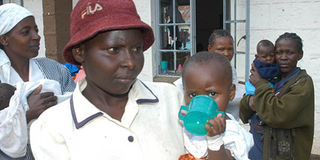Surprise surge in Kenya’s population as fertility rises

Women and their babies. PHOTO/ FILE
What you need to know:
- Ironically, with Kenya making strides in the fight against HIV/Aids, fewer people are dying, keeping death rates lower than birth rates
An increased birth rate among Kenyan women and low levels of contraceptive use are the main causes of the robust population growth in recent years, experts have said.
According to Government demographers, up to 25 per cent of men and women would like to use contraceptives but have no access. The level of contraceptive use remains at 39 per cent, where it was 10 years ago.
Making strides
The experts say an increased number of Kenyan women are bearing more children, with some hoping to gain some form of insurance in numbers against HIV/Aids-related deaths.
Ironically, with Kenya making strides in the fight against HIV/Aids, fewer people are dying, keeping death rates lower than birth rates.
So real are these new observations that National Coordinating Agency for Population and Development (NCAPD) director Boniface K’Oyugi said the Government has had to revise its population projections to 38 million people by next year when a national count will be done.
Initial projections for the National Housing and Population Census pointed to a count of 35 million, with the population expected to hit 36 million in 2010.
Dr K’Oyugi said officials were surmising that more Kenyan women were choosing to have fewer children. Instead, the number of births went up.
Government statistics show that what appeared to be a fertility decline over the previous two decades now looks like the beginnings of an increase.
Fertility had dropped from 8.1 births per woman in 1978 to 4.7 in 1998 when the Kenya Demographic Health Survey (KDHS) was conducted.
The fertility level rose to 4.9 in 2003 and could accelerate if fears that numerous women became pregnant during the post-election violence period are confirmed.
Because many families, especially in the western parts of the country, were forced to stay at home at the time, it is believed many pregnancies could have occurred as a result.
“We cannot confirm that many women became pregnant during the post-poll violence until the next KDHS,” said NCAPD deputy director Kimeli Chepsiror. The next KDHS is this month.
Dr K’Oyugi said the population rise arose because earlier expectations that fertility will drop did not come to pass.
North Eastern Province had a fertility rate of seven children while Western and Rift Valley each had 5.8. Coast had 4.8, Eastern (4.8) and Central, 3.4. Nairobi reported the lowest fertility rate, at 2.7.
The natural increase in population, based on the number of deaths, births and migrations is 2.8 per cent.
Donor funding
Demographers are still pondering whether greater access to contraceptives might have helped rein in the unexpected population rise.
Although demographers hoped that the level of contraceptive use will go beyond 39 per cent, where it stood in 1998, the figure stalled in 2003.
“Because of declining funding, we do not have contraceptive security, meaning we cannot supply as much as we need to,” said Mr Chesiror adding, “we depend too much on donor funding.”
Still unaware
Family Health Options Kenya service delivery manager Esther Muketo said the organisation’s reproductive health programme had suffered from a shift in donor focus from family planning to fighting HIV/Aids.
But NCAPD Coast regional population coordinator Peter Nyakwara said many people are still unaware of available family planning options. Many young women begin child-bearing early due to arranged marriages.
Low literacy levels and poverty are barriers to information and access to contraceptives, especially for rural women.
In other cases, women are bearing more children because of better nutrition and healthcare.
Africa’s population of 967 million is projected to grow to 1.9 billion by 2050, according to the 2008 World Population Data Sheet report.
It says 58 per cent of Kenya’s population lives on less than Sh160 ($2) a day.
The report, released last week, said many African countries were living in poverty with as many as 90 per cent of the population in Tanzania and Nigeria living on less than Sh150 a day.
The report shows that infant and maternal mortality rates are high in Kenya, with 175,000 out of 1.5 million children dying in infancy every year.
A large proportion of those who survive are malnourished with 30 per cent suffering from chronic malnutrition.
About 25 per cent of all child deaths happen in the first month of life, it says, and of these, 17 per cent were due to diarrhoea, 15 per cent to HIV/Aids and 14 per cent were malaria-related.
The 2008 Africa Population Data Sheet said less educated women were more likely to lose their children. It said that 85 infants per 1,000 live births to mothers with primary school education died before one year while 44 out of 1,000 live births to mothers with high school education were dying before celebrating their first birth day.




